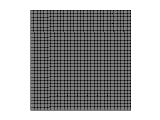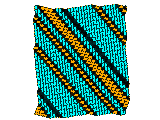
First-order transitions aren't supposed to have precursors (water is water until snap! it's ice), but precursors (elastic softening and the ``central peak'' in inelastic neutron scattering) have been known near first-order crystalline shape transitions for decades. Recent transmission electron micrography on martensites, particularly on the shape memory alloys and doped high-temperature superconductors, showed a cross-hatched ``tweed'' morphology. The tweed modulates between undeformed, high temperature austenite and what looks much like the low-temperature martensite phase, on a length scale of a few atomic spacings. The tweed precursors occurs for tens to a hundred degrees above the nominal phase transition temperature.

|
| Tweed as experimentally observed in transmission electron microscopy of a NiAl alloy (courtesy of Lee Tanner). Tweed is identified by its diagonal striations, which reflect some aperiodic lattice deformation with correlations on the scale of some tens of atomic spacings. |

|

|
| Animation on cooling, and | on heating. |
(I am told by Charlotte Jirousek, a faculty member in Cornell's Textile and Apparel Department, that we've confused a term for a type of cloth with a term for a pattern often woven into that cloth. Tweed is a ``coarse, rugged, often nubby woolen fabric typically made in any of various twill weaves and used chiefly for casual suits and coats." Twill weaves are defined as fabric woven with a diagonal parallel ribbed pattern. We probably should be calling this twill...)
What causes the tweed to modulate? Jim Krumhansl, Sivan Kartha, and I decided that 1/sqrt N concentration fluctuations in the alloys were enough to make some regions transform earlier than others: changing the average concentration by 1%, after all, changes the transition temperature by 100 C. Why the tweedy pattern? We realized that the elastic anisotropy must be involved (since it was the only thing that picked out the two directions of the fibers in the tweed); the elastic anisotropy ranges from a factor of four to a factor of 100 in the various materials. We discovered to our delight that Sivan could solve for the allowed deformations in the limit of infinite elastic anisotropy, and they were precisely the tweedy cross-hatched deformations observed! Finally, would realistic parameters produce the tweedy modulations? Sivan set up a Landau-Ginzburg theory using experimental data from FePd alloys to set the parameters in our (admittedly two-dimensional) model, and found authentic-looking tweed. Later, Sivan's FePd simulations produced an excellent match to the X-ray scattering peak shapes found for high-T_c crystals:


Diffuse Streaking around three Bragg points is shown. (a) Experimental x-ray scattering data (from Jiang et al., PRL 67, 2167 (1991).) for Y Ba_2 Cu(Al)_3 O_(7-delta) around the indicated Bragg peaks. (b) Corresponding diffraction data extracted from the computer simulation of tweed (using FePd parameters) faithfully reproduce important features of the experimental data, i.e. the diffuse streaking is highly anisotropic, most pronounced in the < 11 > directions, and asymmetrically depends on the Bragg peak index. (The experimentalists also got a good fit to the shapes of their peaks, with a much simpler model.)
Of course, simulating tweed isn't the same thing as understanding it. We think tweed is really a spin glass!
This research was paid for by THE US GOVERNMENT through the Department of Energy (DOE #DE-FG02-88-ER45364). Our current work is also supported through the Cornell Theory Center.
![]() James P. Sethna, sethna@lassp.cornell.edu
James P. Sethna, sethna@lassp.cornell.edu
![]() Statistical Mechanics: Entropy, Order Parameters, and Complexity,
now available at
Oxford University Press
(USA,
Europe).
Statistical Mechanics: Entropy, Order Parameters, and Complexity,
now available at
Oxford University Press
(USA,
Europe).